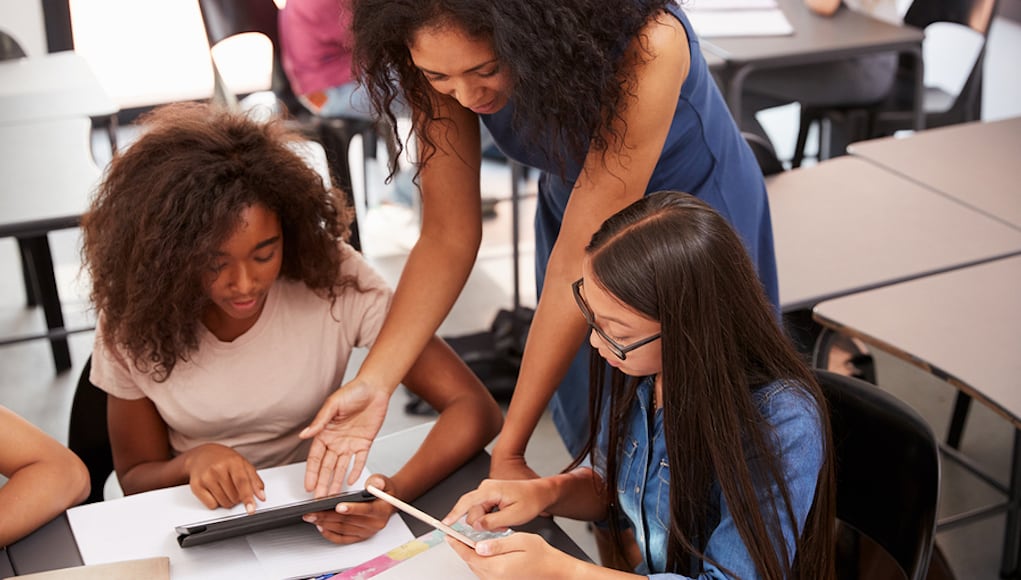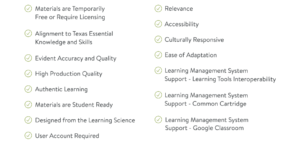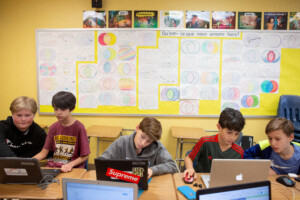5 Classroom Strategies to Support Multimodal Learning

On the first day of school, I’m sure students were expecting the usual “Let’s go around the room and introduce ourselves” spill. Instead, they entered the classroom only to see red cups face down on each of their desks. I asked, “Has anyone ever heard of the cup song from the movie, Pitch Perfect?” Some giggled, some shyly raised their hands, and others stared at me in utter confusion. Nevertheless, I proceeded in showing them the clip from the movie. Following, I showed them a cup song practice video, and when the practice video ended, I said, “Okay, now you do it!” Needless to say, the students reacted in the same way as the initial question with giggles and stares, except for a few who actually attempted. The purpose of the cup song activity was to introduce a conversation about student learning styles and how individualized they can be. Some students enjoyed the hands-on activity, while others would have preferred an oral or written introduction activity.
Knowing your students’ learning styles is important to understand how they process and retain information, as well as to provide them with personalized learning and instruction. Teach.com discusses how all students are created equally, but differently, and how “It is important for educators to understand the differences in their students’ learning styles so that they can implement best practice strategies into their daily activities, curriculum and assessments.” To gain a better understanding of my students’ learning styles, I later had them complete the VARK questionnaire, which is a short survey about visual, aural, read/write, and kinesthetic learning. The results of the questionnaire showed that many students had a combination of the learning styles above. Because of their multiple learning styles, I needed to find creative strategies to incorporate in instruction that would support this multimodal learning environment.
Supporting multimodal learning is also beneficial for teachers to understand how students learn best by implementing strategies in instruction that cater to multiple learning styles. The Gordon Kelley Academic Success Center suggests that “If the student does have multiple learning styles (multimodal), the advantages gained through multiple learning strategies include the ability to learn more quickly and at a deeper level so that recall at a later date will be more successful.” The Center also discusses how “Combining learning modes can also result in a more balanced approach to studying and learning which leads to greater understanding, comprehension, and retention.” Although there is no limit to the learning strategies you can implement in the classroom, I explored five that have shown themselves to be successful in supporting a multimodal learning environment. Each of the strategies below present a different way to personalize instruction and address students’ multiple learning styles within the classroom.
The Perspective Hub– This activity is good for whole-group discussion and active listening. Using tape, you will need to create a circle on the floor and section the circle off in wedges. Label the wedges according to your lesson and/or lesson objective(s). For example, during our Novel Study Unit, I created labels for the wedges based on the following themes from our reading, The Pearl by John Steinbeck: Family, Wealth, Gender, and Good vs. Evil. Students stood in the wedges based on the following questions: 1) Which theme is most apparent to you from the story? Describe its impact on the plot; 2) Which theme can you make a connection to?; and 3) Which theme would you like to explore more within the story? Students moved to the wedges that resonated with them the most and discussed their reasoning whole-group style. Additionally, the perspective hub can also be used to assess student learning in real-time. Display questions on the board that align with the lesson objective(s) and label the wedges according to levels of mastery (ex: Beginning, Progressing, Mastered). You have the ability to tailor the perspective hub according to your content area and student needs. No matter how you shape it, the goal of the perspective hub is to get students out of their desks and moving and allow them to hear and share fresh ideas with their peers, which is ideal for the kinesthetic and auditory learner.
Gallery Walks– Gallery walks are also good for movement and discussion. They serve as visuals that can be used for any subject. Artifacts within the galleries can be teacher or student crafted, depending on the lesson. For example, they can be used as anticipation guides for language arts, and as displays for algebraic problems for math, historical images to draw inferences from for social studies, or parts of an animal or plant cell to identify for science. To best support visual learners, provide them with a graphic organizer to take notes as they tour from image to image.
Technology– Many students enjoy the use of technology. There are countless online tools that support multimodal learning that students can access using either laptops/Chromebooks or their cellphones. To name a few, there are sites such as, Kahoot, Quizizz, Nearpod, CommonLit, and Quizlet that are beneficial for review games and other assessment purposes. Many of these tools allow you to include audio and video features, which supports those who learn best by hearing things. For different assignments and/or presentations, have students utilize online tools like Google Slides/Docs, instead of completing them on a sheet of paper.
Illustration- Sometimes drawing it out is the best way to paint the full picture of one’s learning. For those who teach language arts, allow students to create comic strips using a graphic organizer, in which they can retell key components of a story in art form. Storyboard That is a digital storytelling platform that students can use to create comic strips, as well. This activity is beneficial to visual and kinesthetic learners, especially as they can include color and design their comic strips according to their memory of the lesson. Illustration allows students to really show their creative side simultaneously as they display their learning.
Act-it-out– Role playing is a great activity for movement for the kinesthetic learner. Cindy Phillips of Kinesthetic Classroom Strategies gives an example of how to implement role-playing, stating, “Lesson plans that are made up of several different parts can be staged throughout the classroom. Students can move from stage to stage, digesting each portion individually.” Cindy also encourages the use of props during this role-playing activity, as well. Acting it out gives students the opportunity to move and share learned knowledge based on the instruction.
We set the climate for our classrooms. How our students learn best contributes to how we plan and deliver instruction, which contributes to student engagement and success. The strategies that we implement should not only cater to our students’ learning styles, but they should also help our students get to a place where they can take ownership of their learning and possibly create learning strategies and activities of their own.
If you want to discover how your students learn best, find out according to your learning style. Create a Padlet and have students share their creative ideas about different ways to help them learn. Design a gallery walk with images of different activities for them to choose from. Or, you could simply ask and engage in whole group discussion. No matter what method you choose, learn from them as they learn from you and continue creating a positive culture of learning.
For more, see:
- Podcast: Randy Fielding on Learning Environments for the Future
- Contribution: Schools Alive with Possibility
- A Proposal to End Standardized Testing
Stay in-the-know with innovations in learning by signing up for the weekly Smart Update.







Maritha du Plessis
Kindly confirm if Smart Update is a free weekly.
Replies
Yes, Maritha, it is a free weekly newsletter!
Shumani Tshikota
How did you apply multimodal learning in Teacher Education Development?
Mark Youngblood, UTOP Education
Inspirational commentary. If all teachers had your energy and confidence in the multimodal powers of each student, the world would be a better place.